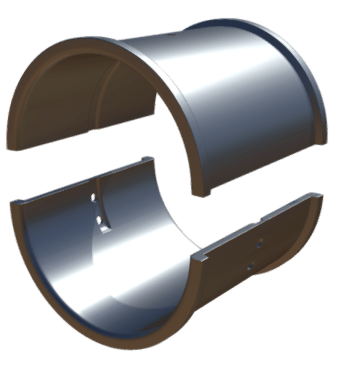Introduction
Bearings allow humans to move an object on, or within, another object. Their main purpose is to extract desired motion from a whole motion. For example, a pump shaft that passes through a pump housing should rotate, but the housing should not. Almost all machines operate with some form of rotating, sliding or oscillating motion, where this occurs, bearings are used.
Bearing Types
There are two main categories of bearing, plain and anti-friction (rolling). Both bearing designs have found widespread application throughout the engineering world, but no single bearing design can cater for all applications. As can be seen on the below images, the two types of bearing are not even slightly similar. This article focuses on the anti-friction ball bearing only.

Anti-Friction Bearing
Anti-Friction Bearing Components
The subject of anti-friction bearings is made more difficult due to the varying terminology that is used to describe identical parts. The below table lists bearing components along with additional common colloquial names.

Anti-Friction Bearing Components
Anti-Friction Bearing Components Table
| Name | Also known as… | Also known as… | Notes |
|---|---|---|---|
| Anti-Friction Bearing | Rolling Bearing | Rolling Element Bearing | Known as rolling bearings, rolling contact bearings and rolling element bearings. |
| Rolling Elements | Rolling elements are of the ball or roller type. | ||
| Race | Ring | Rolling elements are usually held between two bearing races, an inner race and an outer race. When only the outer race is present, the shaft will act as the inner race. | |
| Raceway | Grooves within the inner and outer rings form the raceway. Rolling elements roll within the raceway. | ||
| Cage | Retainer | Separator | The cage spaces the rolling elements apart from each other. |
| Inner Ring | Inner Race | Cone | Forms the inner part of an anti-friction bearing (the part that presses against the shaft). The inner ring usually rotates with the shaft. The term ‘cone’ is usually reserved for tapered bearings only, although many publications make no distinction between the inner ring/race and cone. |
| Outer Ring | Outer Race | Cup | Forms the outer part of an anti-friction bearing. The outer ring does not usually rotate with the shaft. The term ‘cup’ is usually reserved for tapered bearings only, although many publications make no distinction between the outer ring/race and cup. |
Anti-Friction Ball Bearings
Ball bearings are probably the most widely known bearing and easiest to identify. This type of bearing operates upon point contact with one stationary ring (usually the outer ring) and one rotating ring.

Anti-Friction Bearing Operation
Common ball bearing designs include single row, double row, thrust and angular contact. Each design of ball bearing caters for the different loads it is likely to encounter.

Thrust Ball Bearing
Single and Double Row
Single row ball bearings are incredibly versatile, they can be used for medium-high radial loads and light thrust loads, in either direction. It is possible to have a maximum capacity bearing that contains more rolling elements, this increases the radial load the bearing can carry but reduces its axial load carrying capacity.
Double row ball bearings can carry more radial load than their single row counterparts but are wider. This type of bearing can support heavy radial loads and low-medium axial loads, in either direction.

Double Row Ball Bearings
Shallow Groove and Deep Groove
Ball bearings may be shallow groove or deep groove. The 'groove' is the depth of the raceway into which the balls fit. Deep groove single row ball bearings are also known as Conrad bearings. Deep groove ball bearings can carry higher radial and axial loads than their shallow groove ball bearing counterparts.

Conrad Deep Groove Single Row Ball Bearing
How Ball Bearings Work
The below video is an extract from our Anti-Friction Bearing Fundamentals Online Video Course.
Related Online Engineering Courses
Anti-Friction Bearing Fundamentals
Additional Resources
https://en.wikipedia.org/wiki/Bearing_(mechanical)
http://courses.washington.edu/engr100/Section_Wei/engine/UofWindsorManual/Bearings.htm
https://www.niushangcn.com/resources/deep-groove-ball-bearing-animated-explained.html

